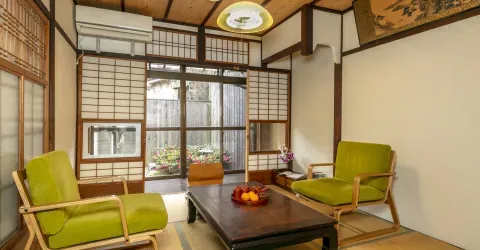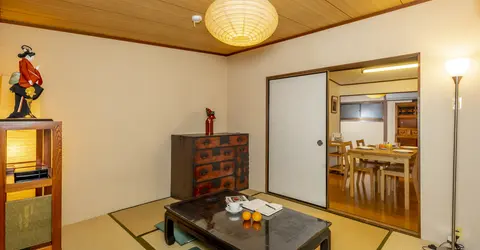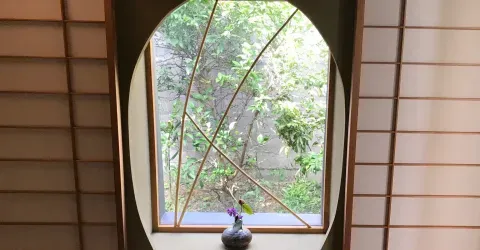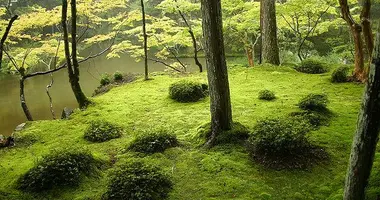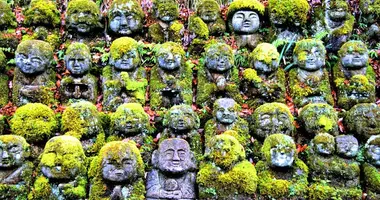Ginkakuji - The Silver Pavilion temple of Kyoto
- Published on : 27/02/2024
- by : Japan Experience
- Youtube
History and origins of Ginkakuji
The story of Ginkakuji begins in the late 15th century, during the tumultuous Muromachi period in Japan. Shogun Ashikaga Yoshimasa, a great patron of the arts despite his political struggles, decided to build his retirement villa in the tranquil hills of Higashiyama. Inspired by his grandfather's famous Kinkakuji, or Golden Pavilion, Yoshimasa envisioned a similarly spectacular retreat.
Construction on the villa began in 1482, but was halted due to the outbreak of the Onin War, a civil conflict that ravaged Kyoto. Despite the setbacks, Yoshimasa remained committed to his vision. He lived in the villa from 1484 until his death in 1490, immersing himself in the arts and culture that would come to define the Higashiyama period.
After Yoshimasa's passing, the villa was converted into a Zen temple, as per his wishes. It was given the name Jishō-ji, which means "Temple of Shining Mercy," though it is better known today by its informal name, Ginkakuji or Silver Pavilion.
Architecture of the Silver Pavilion and other temple buildings
The centerpiece of Ginkakuji is the two-story Silver Pavilion, or Kannonden Hall. Despite its name, the pavilion was never actually covered in silver. Some believe that Yoshimasa intended to coat the structure in silver leaf, similar to the gold leaf used on Kinkakuji, but this plan was never realized. Others suggest that the name refers to the moonlight reflecting off the pavilion's dark exterior, giving it a silvery appearance.
The Silver Pavilion's architecture seamlessly blends Japanese and Chinese styles. The first floor, called the Shinkuden, or "Hall of the Floating Heart," features a traditional Japanese residential design with tokonomaalcoves and delicate shoji screens. In contrast, the second floor, known as the Choondo, or "Tower of Roaring Waves," showcases a more Chinese-inspired temple style with bell-shaped windows and an open balcony.
Another notable structure within Ginkakuji is the Togudo, a modest yet elegant building that served as Yoshimasa's private Buddha Hall. The Togudo is considered the oldest extant example of shoin-zukuri, a traditional Japanese residential architecture style characterized by tatami mats, shoji screens, and alcove shelves that would later become standard features in Japanese homes.
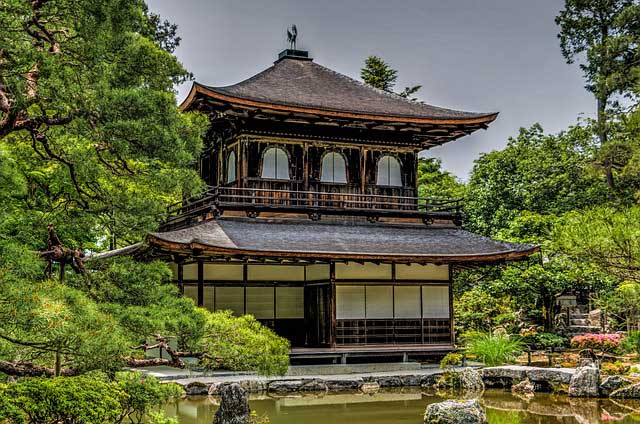
The exquisite gardens of Ginkakuji
The gardens surrounding the Silver Pavilion are a masterpiece of Japanese landscape design. Attributed to the renowned artist and garden designer Sōami, these meticulously crafted spaces embody the principles of Zen Buddhism and the aesthetic of wabi-sabi, which finds beauty in simplicity, imperfection, and the passage of time.
One of the most iconic features of Ginkakuji's gardens is the "Sea of Silver Sand," a large, dry sand garden with a massive sand cone known as the "Moon Viewing Platform." The white sand is carefully raked into mesmerizing patterns, representing the ripples on a vast ocean. The sand cone is said to symbolize Mount Fuji, creating a miniature landscape that invites contemplation and meditation.
The temple grounds also boast a lush moss garden, with vibrant green carpets of moss covering the forest floor. A tranquil pond, islands, and stone bridges create a serene atmosphere, while the strategically placed rocks and plants offer different perspectives as visitors stroll through the garden.
Ginkakuji's influence on Japanese arts and culture
Under Ashikaga Yoshimasa's patronage, Ginkakuji became the center of the Higashiyama culture, a period of great artistic and cultural development in Japan. Many of the traditional arts we associate with Japan today, such as the tea ceremony, flower arrangement, Noh theater, poetry, and landscape design, flourished during this time.
The Togudo building at Ginkakuji is particularly significant, as it is believed to house the oldest surviving tea room in Japan. This small, 4.5-tatami mat room, known as the Dojinsai, served as a model for future tea ceremony spaces and helped establish the tea ceremony as a cornerstone of Japanese culture.
The aesthetic principles embodied by Ginkakuji, particularly the concept of wabi-sabi, have had a lasting impact on Japanese art and design. The appreciation for simplicity, imperfection, and the beauty of natural materials can be seen in various aspects of Japanese culture, from ceramics and architecture to literature and philosophy.
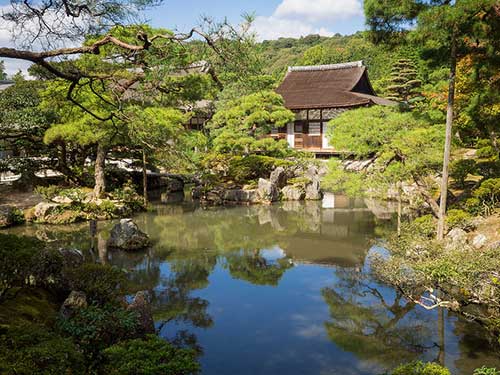
Visiting Ginkakuji - Practical information
Ginkakuji is located in the Sakyo ward of eastern Kyoto, at the foot of the Higashiyama mountains. The temple is easily accessible by public transportation:
- From Kyoto Station, take bus number 5 or 100 to the Ginkakuji-michi bus stop, then walk a short distance to the temple entrance.
- Alternatively, you can reach Ginkakuji on foot by following the scenic Philosopher's Path from Nanzenji Temple, a walk of approximately 30-45 minutes.
The temple is open daily from 8:30 am to 5:00 pm (March to November) and 9:00 am to 4:30 pm (December to February). Admission fees are 500 yen for adults and 300 yen for school-aged children.
To fully appreciate the beauty and tranquility of Ginkakuji, plan to spend at least an hour exploring the temple buildings and gardens. Consider visiting early in the morning or later in the afternoon to avoid the largest crowds, especially during peak travel seasons like spring and autumn.
Ginkakuji through the seasons
One of the most enchanting aspects of Ginkakuji is how its beauty transforms with the changing seasons. Each time of year offers a unique perspective on the temple and its gardens:
- In spring, the grounds come alive with the soft pinks and whites of cherry blossoms, creating a dreamy atmosphere as petals drift on the breeze.
- Summer brings lush greenery, with the vibrant moss gardens and cool shade of the temple buildings offering a welcome respite from the heat.
- Autumn sees the temple grounds ablaze with the fiery reds, oranges, and golds of changing maple leaves, a breathtaking sight that draws visitors from around the world.
- Winter blankets Ginkakuji in a serene layer of snow, the stark white contrasting beautifully with the dark wood of the temple structures and the silvery sand of the dry garden.
No matter when you visit, Ginkakuji's timeless beauty and tranquil atmosphere are sure to leave a lasting impression.
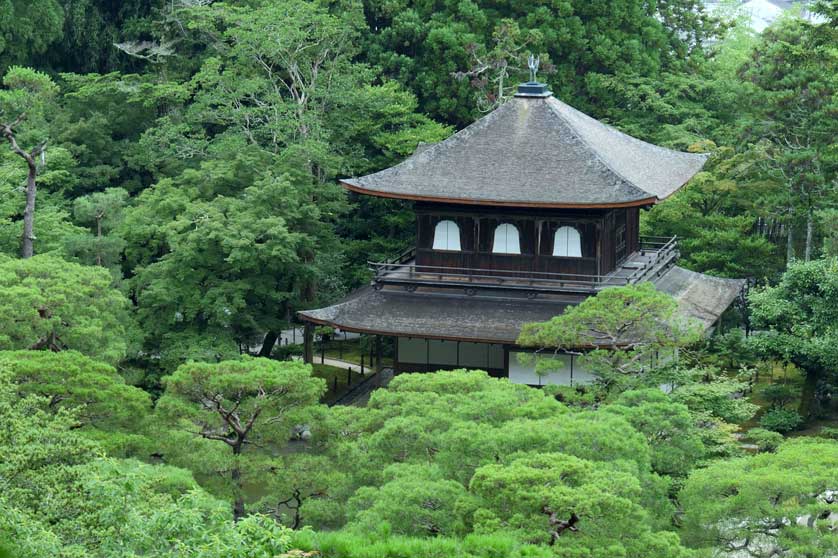
The spiritual significance and Zen philosophy of Ginkakuji
As a Zen temple, Ginkakuji embodies the core principles and philosophies of Zen Buddhism. The temple's minimalist aesthetics and serene gardens are designed to encourage meditation, self-reflection, and a deeper understanding of the impermanent nature of existence.
The concept of wabi-sabi, which is deeply rooted in Zen philosophy, is exemplified throughout Ginkakuji. By embracing simplicity, imperfection, and the natural cycle of growth and decay, the temple invites visitors to contemplate the fleeting nature of life and find beauty in the present moment.
The Silver Pavilion itself serves as a powerful symbol of this philosophy. Its unadorned, weathered exterior reminds us that even the most magnificent structures are subject to the passage of time and the forces of nature. By accepting and appreciating the imperfections that come with age, we can find a profound sense of peace and connection to the world around us.
Ginkakuji's gardens, too, are imbued with deep spiritual meaning. The meticulously raked sand and strategically placed rocks are not merely decorative, but serve as tools for meditation and contemplation. The act of maintaining and caring for these gardens is itself a form of Zen practice, a way of cultivating mindfulness, patience, and a deep appreciation for the beauty of the present moment.
As visitors walk the paths of Ginkakuji, surrounded by the tranquil sounds of nature and the gentle rustling of leaves, they are invited to slow down, breathe deeply, and connect with the profound wisdom of Zen Buddhism. In this way, Ginkakuji serves not only as a monument to Japan's rich cultural heritage but as a sanctuary for the soul, offering a space for quiet reflection and spiritual growth.

Raked white sand at Ashikaga Yoshimasa's delightful Ginkakuji
Nestled in the serene hills of eastern Kyoto, Ginkakuji is a stunning Zen temple renowned for its exquisite architecture and tranquil gardens. Originally constructed in 1482 as a retirement villa for the powerful shogun Ashikaga Yoshimasa, Ginkakuji, also known as the Silver Pavilion, was later converted into a Buddhist temple. Today, this UNESCO World Heritage Site attracts visitors from around the globe who come to admire its beauty and immerse themselves in the rich history of Kyoto.
